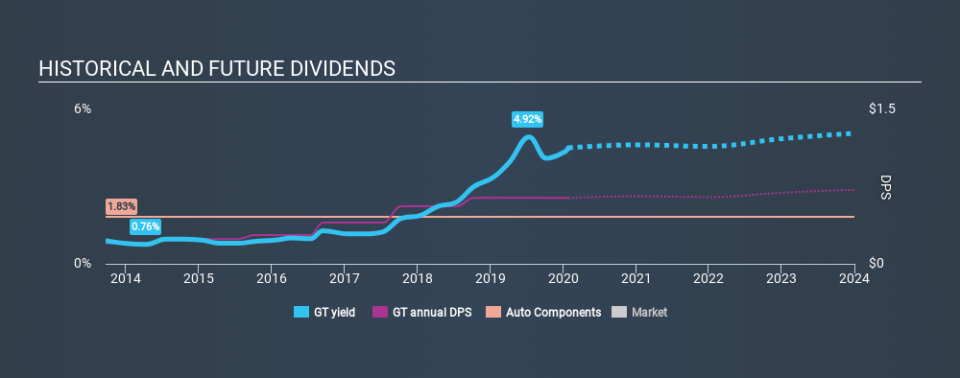We Wouldn't Be Too Quick To Buy The Goodyear Tire & Rubber Company (NASDAQ:GT) Before It Goes Ex-Dividend

The Goodyear Tire & Rubber Company (NASDAQ:GT) is about to trade ex-dividend in the next 3 days. This means that investors who purchase shares on or after the 31st of January will not receive the dividend, which will be paid on the 2nd of March.
Goodyear Tire & Rubber's next dividend payment will be US$0.16 per share, on the back of last year when the company paid a total of US$0.64 to shareholders. Based on the last year's worth of payments, Goodyear Tire & Rubber has a trailing yield of 4.5% on the current stock price of $14.2. We love seeing companies pay a dividend, but it's also important to be sure that laying the golden eggs isn't going to kill our golden goose! That's why we should always check whether the dividend payments appear sustainable, and if the company is growing.
See our latest analysis for Goodyear Tire & Rubber
If a company pays out more in dividends than it earned, then the dividend might become unsustainable - hardly an ideal situation. Its dividend payout ratio is 78% of profit, which means the company is paying out a majority of its earnings. The relatively limited profit reinvestment could slow the rate of future earnings growth It could become a concern if earnings started to decline. Yet cash flows are even more important than profits for assessing a dividend, so we need to see if the company generated enough cash to pay its distribution. Over the last year, it paid out dividends equivalent to 339% of what it generated in free cash flow, a disturbingly high percentage. It's pretty hard to pay out more than you earn, so we wonder how Goodyear Tire & Rubber intends to continue funding this dividend, or if it could be forced to the payment.
Goodyear Tire & Rubber paid out less in dividends than it reported in profits, but unfortunately it didn't generate enough cash to cover the dividend. Were this to happen repeatedly, this would be a risk to Goodyear Tire & Rubber's ability to maintain its dividend.
Click here to see the company's payout ratio, plus analyst estimates of its future dividends.
Have Earnings And Dividends Been Growing?
When earnings decline, dividend companies become much harder to analyse and own safely. If earnings fall far enough, the company could be forced to cut its dividend. Readers will understand then, why we're concerned to see Goodyear Tire & Rubber's earnings per share have dropped 20% a year over the past five years. Ultimately, when earnings per share decline, the size of the pie from which dividends can be paid, shrinks.
Another key way to measure a company's dividend prospects is by measuring its historical rate of dividend growth. In the last six years, Goodyear Tire & Rubber has lifted its dividend by approximately 21% a year on average. That's intriguing, but the combination of growing dividends despite declining earnings can typically only be achieved by paying out a larger percentage of profits. Goodyear Tire & Rubber is already paying out 78% of its profits, and with shrinking earnings we think it's unlikely that this dividend will grow quickly in the future.
The Bottom Line
Should investors buy Goodyear Tire & Rubber for the upcoming dividend? It's definitely not great to see earnings per share shrinking. The company paid out an acceptable percentage of its income, but an uncomfortably high percentage of its cash flow over the past year. It's not an attractive combination from a dividend perspective, and we're inclined to pass on this one for the time being.
Curious what other investors think of Goodyear Tire & Rubber? See what analysts are forecasting, with this visualisation of its historical and future estimated earnings and cash flow.
We wouldn't recommend just buying the first dividend stock you see, though. Here's a list of interesting dividend stocks with a greater than 2% yield and an upcoming dividend.
If you spot an error that warrants correction, please contact the editor at editorial-team@simplywallst.com. This article by Simply Wall St is general in nature. It does not constitute a recommendation to buy or sell any stock, and does not take account of your objectives, or your financial situation. Simply Wall St has no position in the stocks mentioned.
We aim to bring you long-term focused research analysis driven by fundamental data. Note that our analysis may not factor in the latest price-sensitive company announcements or qualitative material. Thank you for reading.

 Yahoo Finance
Yahoo Finance 
